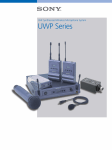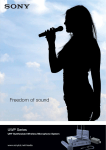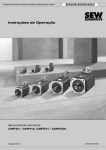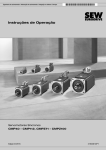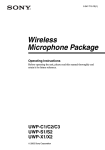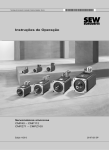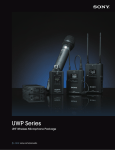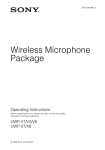Download Sony SRP-X500P User's Manual
Transcript
SONy BID SPECIFICATION FOR POWERED MIXER MODEL NUMBER SRP-X500P INSTRUCTIONS: REMOVE THIS COVER PAGE AND ADD TO REQUESTS FOR QUOTATION AND PROPOSALS. THE OBJECTIVE OF THIS BID SPECIFICATION IS TO ASSIST YOU IN CLEARLY SPECIFYING THE SONY PRODUCT IDENTIFIED ABOVE, AND ENSURING THAT THE BUYER IS WELL INFORMED OF THE HIGH STANDARD OF PERFORMANCE THAT IS TO BE EXPECTED OF A SONY PRODUCT. THE INFORMATION IN THIS DOCUMENT IS CURRENT AS OF JUNE 2006. PRODUCT SPECIFICATIONS ARE SUBJECT TO CHANGE WITHOUT NOTICE. 1.0 General Information The purpose of this information is to provide the specification for a product whose primary purpose is the signal distribution of audio, video and / or computer graphics information to audio speakers, video or graphics displays or other processing devices. The distribution of these signals is to be accomplished via a rack mountable signal processing device. This document provides the minimum specifications for this device. 2.0 Description This product shall be classified as an audio and video signal processing device. This device shall be directly compatible with microphone and line level audio sources and video and computer sources, without the use of external devices to provide this compatibility. This device shall employ the use of digital signal processing and control to ensure maximum flexibility and performance in the system environment. Encased in a durable metal housing, this device shall employ a shape that allows for rack mounting in a 19” EIA standard rack, using included rack mount capability. The unit shall occupy no more than 3 EIA rack units. 3.0 Source Compatibility / Suitability for Application This device shall be directly compatible with the following audio sources. Balanced / Unbalanced microphone sources (Phantom power on or off) Balanced / Unbalanced line level sources. This device shall be compatible with the following video and computer signal sources. NTSC Video (Composite) PAL Video (Composite) PAL-M Video (Composite) PAL-N Video (Composite) SECAM Video (Composite) Modified NTSC 4.43 (Composite) Component Video (50 and 60 Hz) 480P (60Hz) 575P (50Hz) 720P (60Hz) 1035i (60Hz) 1080i (50 and 60Hz) VGA Computer Graphics (Modes 1, 2 and 3, 60 – 85Hz) VESA 800x600 Computer Graphics (56 – 85Hz) VESA 1024x768 Computer Graphics (43 – 85Hz) VESA 1152 x 864 Computer Graphics (70 – 75Hz) SUN 1152 x 900 Computer Graphics (65 – 76Hz) VESA 1280 x 1024 Computer Graphics (43 – 60Hz) Mac 13” Computer Graphics Mac 16” Computer Graphics 4.0 User Interface / Controllability Information Control of this device shall be accomplished through one of the following methods: Front Panel Control Serial control jack for control by external systems or Computer. Advanced serial control jack for control by external control systems Parallel (Contact closure) control jack for control by external systems IR control (From universal learning type remote) All of these control methods shall be standard to the device. In addition, this device shall be able to control external and display devices. This shall be accomplished through one or more of the following methods. Serial control jack for control of projector or display. Advanced serial control jack for control of projector or display. All of these control methods shall also be standard to the device. The front panel controls shall allow the operator manual control over the setup and configuration of the device. All functions available for control shall be directly accessible on individual controls, and metering of various audio signals shall be possible from independent LED’s. The serial control jack shall employ the use of a standardized device control protocol that is commonly accepted and understood by control systems manufacturers. This control jack shall accept unidirectional serial commands that provide full control over the device. The advanced serial control jack shall employ the use of a standardized device control protocol that is commonly accepted and understood by control systems manufacturers. This control jack shall accept and transmit bi-directional serial commands that provide full control over the device, and provide acknowledgement to the control system of the received command. The parallel (contact closure) control jack shall employ the use of standardized device control protocol that is commonly accepted and understood by control systems manufacturers. This control jack shall accept and transmit commands based on the state of specific contacts, when shorted to ground. This method shall provide limited control over the device, and provide acknowledgement to the control system of the received command. The following device functions shall be available for control using this method. A/V source selection Volume control Muting Scene recall Projector power on / stand by Emergency override The IR (Infrared) control capability shall employ the use of standardized device control protocol that is commonly accepted and understood by control systems manufacturers. Through the use of an external Universal (learning) IR remote control unit, this method shall provide limited control over the device. The following device functions shall be available for control using this method. Projector power on / standby AV/RGB source selection Master volume adjustment Master muting The serial control output jack shall employ the use of standardized device control protocol that is commonly accepted and understood by control systems manufacturers. This control jack shall transmit uni-directional serial commands that provide full control over the projector or display. The controllable projectors or displays shall include those with a compatible control input from the supplying manufacturer. The following device functions shall be available for control using this method. Power On / Standby Input Selection 5.0 Performance Specifications This device shall fully support all video color systems using pass-through capability. The maximum video bandwidth shall be at least 10MHz. The maximum RGB bandwidth shall be at least 150MHz. The device shall be capable of passing a resolution of at least 1280 x 1024 pixels at 60Hz refresh. This device shall support audio signals within the frequency range of 20Hz to 20,000Hz This device shall include four channels of built-in audio amplifiers. Two of these channels should be capable of producing 90w per channel to 8 or 4 Ohm speaker loads. The remaining two amplifiers should be capable of producing 50w per channel to 8 or 4 Ohm speaker loads, or combined to produce 60w into high impedance (70v) line systems. This device shall have a minimum audio signal to noise ratio of 94dB (IHF- A), with less than -80dB of crosstalk between adjacent audio channels. This device shall provide +48V DC (phantom) power to the microphone inputs for use with condenser type microphones. This feature shall be switchable on or off independently for each microphone input channel. This device shall provide slots for the integration of two wireless microphone tuner modules, for use with handheld or bodypack style transmitters. The transmitters and modules shall be available from the supplying manufacturer as options. Dual UHF antennas shall also be accommodated, as an option, to support full diversity reception on the wireless system. 6.0 Dimensional Information This device shall have maximum cabinet dimensions of 5.25 inches high by 19 inches wide by14 inches deep. This device shall fit into a standard 19” EIA rack, occupying no more than 3 EIA rack spaces. This device, without options, shall not weigh more than 27 pounds. 7.0 Connectivity Information This device shall provide for connection of multiple source devices without employing the use of an external interface. These connections shall include the following: (4) Balanced microphone inputs on XLR 3-pin connectors (1) Unbalanced stereo line input on RCA (Phono) connectors (5) Unbalanced stereo inputs on RCA (Phono) connectors for AV/RGB source follow. (3) Composite video inputs on RCA (Phono) connectors (2) Component / Analog RGB inputs on HD15 (VGA) connectors (4) Unbalanced line outputs on RCA (Phono) connectors (2) 4-16 Ohm speaker outputs on screw type binding terminals. (2) 4-16 Ohm / 70V speaker outputs on screw type binding terminals (1) Composite video output on RCA (Phono) connector (1) Component / Analog RGB output on HD-15 (VGA) connector 8.0 Power Requirements This device shall accept power at 120 VAC / 60Hz. This device shall consume no more than 120W. Power to this device shall be supplied via a detachable, standard power cord that is readily available for replacement from local suppliers. 9.0 Warranty Information This device shall carry a 90-day labor and 1-year parts manufacturer’s warranty. Authorized servicing dealers of the devices manufacturer shall perform warranty service.






